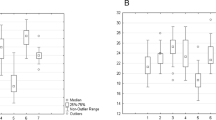Abstract
Spores from 19 species of the subgenus Aloma Kindb. of the moss genus Fissidens were analyzed by light and scanning electron microscopy. Aloma is the largest subgenus of Fissidentaceae and is characterized by the presence of a peristome of scariosus type. The spores of the subgenus Aloma are present in monads, size small to very small, heteropolar, plano-convex, with a proximal aperture region, and the sporoderm is formed by a perine, exine, and intine. The intine is not stratified, the exine is psilate, and the perine granulated. The ornamentation elements may occur singly or grouped on the surface of the spore. The aperture region shows irregular contours, ranging from circular to elongated, due to the weakness of the sporoderm proximal pole. The observed variations among species are related to different patterns of distribution of the sporoderm granules and nanogranules. Quantitative analysis combined with qualitative results did not allow all species of the subgenus Aloma to be distinguished. The results of this study demonstrate that the spore is a useful tool for taxonomic studies, and suggest that its characters be included in phylogenetic analyses, to assist in the reconstruction of the evolutionary history of mosses.



Similar content being viewed by others
Abbreviations
- DM:
-
Largest diameter in polar view
- Dm:
-
Smallest diameter in polar view
- st:
-
Sclerine thickness
- \( \overline{X} \) :
-
Mean
- S:
-
Standard deviation
- \( {\text{S}}_{{\bar{X}}} \) :
-
Standard error
- CI:
-
Confidence interval
- CV:
-
Coefficient of variability
- R:
-
Range
- SEM:
-
Scanning electron microscopy
- LM:
-
Light microscopy
References
Barth OM, Melhem TS (1988) Glossário ilustrado de palinologia. Editora Unicamp, Campinas
Brown RC, Lemon BE (1988) Sporogenesis in bryophytes. Adv Bryol 3:159–223
Caldeira IC, Gonçalves-Esteves V, Luizi-Ponzo AP (2006) Morfologia dos esporos das espécies de Leucobryaceae Schimp. 110 (Bryophyta) do Parque Estadual de Ilha Grande, Município de Angra dos Reis, Estado do Rio de Janeiro. Revista Brasileira de Botânica 29:301–307
Dabhade GT, Patil VV (2001) Palynology of some mosses from Western Ghats under SEM. In: Nath V, Asthana AK (eds) Perspectives in Indian bryology: proceedings national conference on bryology. Bishen Singh Mahendra Pal Singh, Dehra Dun, India, pp 127–133 [Spores of Fissidens examined]
Erdtman G (1957) Pollen and spore morphology and plant taxonomy. Gymnospermae, Pteridophyta Bryophyta (Illustrations). An Introduction to palynology II. The Cronica Company, Stockholm
Florschütz P (1964) The mosses of Suriname. Part I. Flora of Suriname 6(1):1–271
Florschütz P (1967) Mosses from the Netherlands Antilles. Acta Botanica Neerlandica 15:524–529
La Farge C, Mishler BD, Whealer JA, Wall DP, Johannes K (2000) Phylogenetic relationships within the Haplolepideous mosses. Bryologist 103:257–276
Luizi-Ponzo AP, Barth OM (1998) Spore morphology of some Bruchiaceae species (Bryophyta) from Brazil. Grana 37:222–227
Luizi-Ponzo AP, Barth OM (1999) Spore morphology of some Dicranaceae species (Bryophyta) from Brazil. Grana 38:42–49
Luizi-Ponzo AP, Melhem TS (2006) Spore morphology and ultrastructure of the tropical moss Helicophyllum torquatum (Hook.) Brid. (Helicophyllaceae) in relation to systematics and evolution. Cryptogamie Bryologie 27:413–420
Luizi-Ponzo AP, Barth OM, Lisboa RCL (1997) Estudos palinológicos em briófitas. In: Lisboa PLB Caixiuanã, Museu Paranaense Emílio Goeldi and MCT/CNPQ, Belém, p 305–318
Mogensen GS (1981) The biological significance of morphological characters in Bryophytes: the spore. Bryologist 84:187–207
Mogensen GS (1983) The spore. In: Schuster RM (ed) New manual of bryology, 1st edn, Hattori Botanical Laboratory, Nichinan p 326–341
Müller C (1900–1901) Genera Muscorum Frondosorum. E. Kummer, Leipzig
Olensen P, Mogensen GS (1978) Ultrastructure, histochemistry and notes on germination stages of spores in selected mosses. Bryologist 81:493–516
Punt W, Hoen P, Blackmore S, Nilsson S, Le Thomas A (2007) Glossary of pollen and spore terminology. http://www.bio.uu.nl/~palaeo/glossary/glosint.htm (Accessed on 10/03/2008)
Pursell RA (1994) Taxonomic notes on Neotropical Fissidens. Bryologist 97:253–271
Pursell RA (2007) Flora Neotropica Monograph 101. The New York Botanical Garden, New York
Pursell RA, Bruggeman-Nannenga MA (2004) A Revision of the Infrageneric Taxa of Fissidens. Bryologist 107(1):1–20
Wodehouse RP (1935) Pollen grains: their structure, identification and significance in science and medicine. McGraw-Hill, New York
Acknowledgments
The authors are grateful to the Centro Universitário do Leste de Minas Gerais (Unilestemg), Universidade Federal do Rio de Janeiro/Museu Nacional do Rio de Janeiro, Universidade Federal de Juiz de Fora for logistical support and facilities, to the curators of herbaria in Brazil: Herbarium Maria Eneida P. Kauffman Fidalgo, Institute of Botany, Department of the Environment of the State of São Paulo (SP); Herbarium of the Botany Department of the Emílio Goeldi Museum Paraense in Belém, State of Pará (MG); Plant Systematics and Evolution Herbarium of the Botany Department of the National Museum of Rio de Janeiro, Rio de Janeiro (R); Herbarium of the Anchieta Research Institute, São Leopoldo, State of Rio Grande do Sul (PACA), University Herbarium of the State of Rio de Janeiro, Rio de Janeiro, State of Rio de Janeiro (HRJ); and Laboratory for Microscopy and Microanalysis, Federal University of Viçosa.
Author information
Authors and Affiliations
Corresponding author
Rights and permissions
About this article
Cite this article
Caldeira, I.C., Luizi-Ponzo, A.P. & Esteves, V.G. Palynology of selected species of Fissidens (Hedw.). Plant Syst Evol 299, 187–195 (2013). https://doi.org/10.1007/s00606-012-0714-5
Received:
Accepted:
Published:
Issue Date:
DOI: https://doi.org/10.1007/s00606-012-0714-5




